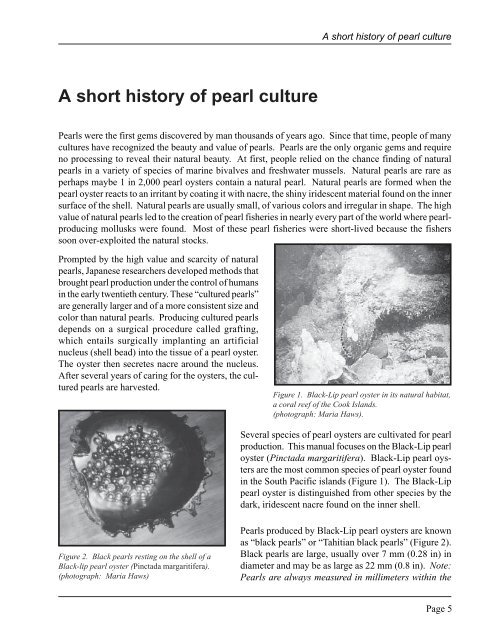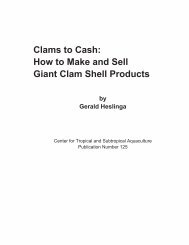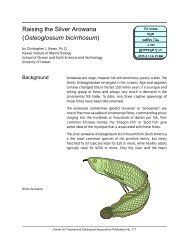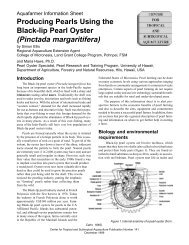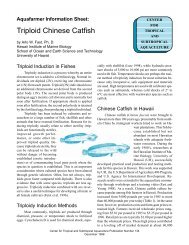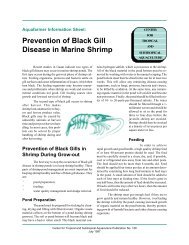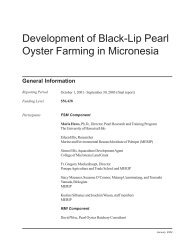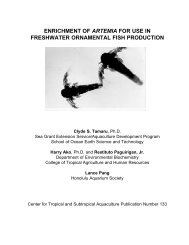The Basic Methods of Pearl Farming: A Layman's Manual - CTSA
The Basic Methods of Pearl Farming: A Layman's Manual - CTSA
The Basic Methods of Pearl Farming: A Layman's Manual - CTSA
You also want an ePaper? Increase the reach of your titles
YUMPU automatically turns print PDFs into web optimized ePapers that Google loves.
A short history <strong>of</strong> pearl cultureA short history <strong>of</strong> pearl culture<strong>Pearl</strong>s were the first gems discovered by man thousands <strong>of</strong> years ago. Since that time, people <strong>of</strong> manycultures have recognized the beauty and value <strong>of</strong> pearls. <strong>Pearl</strong>s are the only organic gems and requireno processing to reveal their natural beauty. At first, people relied on the chance finding <strong>of</strong> naturalpearls in a variety <strong>of</strong> species <strong>of</strong> marine bivalves and freshwater mussels. Natural pearls are rare asperhaps maybe 1 in 2,000 pearl oysters contain a natural pearl. Natural pearls are formed when thepearl oyster reacts to an irritant by coating it with nacre, the shiny iridescent material found on the innersurface <strong>of</strong> the shell. Natural pearls are usually small, <strong>of</strong> various colors and irregular in shape. <strong>The</strong> highvalue <strong>of</strong> natural pearls led to the creation <strong>of</strong> pearl fisheries in nearly every part <strong>of</strong> the world where pearlproducingmollusks were found. Most <strong>of</strong> these pearl fisheries were short-lived because the fisherssoon over-exploited the natural stocks.Prompted by the high value and scarcity <strong>of</strong> naturalpearls, Japanese researchers developed methods thatbrought pearl production under the control <strong>of</strong> humansin the early twentieth century. <strong>The</strong>se “cultured pearls”are generally larger and <strong>of</strong> a more consistent size andcolor than natural pearls. Producing cultured pearlsdepends on a surgical procedure called grafting,which entails surgically implanting an artificialnucleus (shell bead) into the tissue <strong>of</strong> a pearl oyster.<strong>The</strong> oyster then secretes nacre around the nucleus.After several years <strong>of</strong> caring for the oysters, the culturedpearls are harvested.Figure 1. Black-Lip pearl oyster in its natural habitat,a coral reef <strong>of</strong> the Cook Islands.(photograph: Maria Haws).Several species <strong>of</strong> pearl oysters are cultivated for pearlproduction. This manual focuses on the Black-Lip pearloyster (Pinctada margaritifera). Black-Lip pearl oystersare the most common species <strong>of</strong> pearl oyster foundin the South Pacific islands (Figure 1). <strong>The</strong> Black-Lippearl oyster is distinguished from other species by thedark, iridescent nacre found on the inner shell.Figure 2. Black pearls resting on the shell <strong>of</strong> aBlack-lip pearl oyster (Pinctada margaritifera).(photograph: Maria Haws)<strong>Pearl</strong>s produced by Black-Lip pearl oysters are knownas “black pearls” or “Tahitian black pearls” (Figure 2).Black pearls are large, usually over 7 mm (0.28 in) indiameter and may be as large as 22 mm (0.8 in). Note:<strong>Pearl</strong>s are always measured in millimeters within thePage 5


